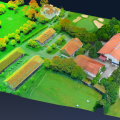
New satellite-based technology is being used to create ’fast lanes‘ for commercial planes in US airspace.
The equivalent of ’bus and taxi‘ lanes are being created in the skies above 22 airports that aim to help reduce traffic jams that often clog airports.
Southwest, American, United and Alaska airlines have already spent millions of dollars on the new technologies, which allow much more precise manoeuvres around busy airports by providing more accurate location data.
Those using older navigation systems must be kept further apart as their precise location is less accurately pinpointed.
The routes are part of a broad Federal Aviation Administration effort – known as Nextgen – to redesign an outmoded air-traffic system in which one in five flights is delayed.
About 40 per cent of US commercial aircraft are equipped to fly the new routes, according to the FAA.
If successful, the wide-ranging NextGen projects in development would slash flight delays by 21 per cent over the next eight years and by 31 per cent by 2030, the FAA said, and the efficiencies would save 7.2 billion gallons of fuel.
Two of the core technologies under Nextgen are the Automatic Dependent Surveillance-Broadcast (ADS-B) and the Wide Area Multilateration (WAM) system.
The relative location of aircraft equipped with ADS-B can be pinpointed more precisely by air traffic controllers and pilots.
Meanwhile, WAM is a ground-based system of small sensors that receive aircraft transponder signals and triangulate them to determine precise locations.







